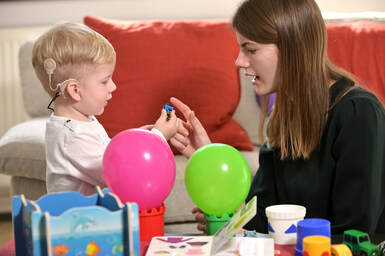Articulation and Phonology
Speech sound disorders are communication disorders in which children have difficulty saying words or sounds correctly. This can be a typical pattern as children are learning new words, but a child that produces these sounds in error past an expected age may have a speech sound disorder.
Articulation describes how we produce certain sounds in our mouths as we produce words. A disorder in the area of articulation will typically involve a substitution, like /w/ for /r/ as in "wabbit" for "rabbit" , or distortions, such as a tongue thrust or a lisp.
Phonology describes how we use sounds as a pattern in connected speech. A disorder in the area of phonology will involve a display of errors in a consistent pattern of sound substitutions and omissions. For example, children with a phonological pattern of "fronting" will produce sounds made with the back of the tongue, like /k/ and /g/, with the front of the mouth, turning those to /t/ and /d/ sounds. So the /k/ in "key" becomes a /t/, turning the word to "tea," and a /g/ in the word "go" becomes a /d/, turning the word to "doe." The more phonological patterns produced by a child, the more difficult they are to understand. If a child cannot be understood by strangers at least 75% of the time by the age of 3, a speech assessment is recommended.
Phonology describes how we use sounds as a pattern in connected speech. A disorder in the area of phonology will involve a display of errors in a consistent pattern of sound substitutions and omissions. For example, children with a phonological pattern of "fronting" will produce sounds made with the back of the tongue, like /k/ and /g/, with the front of the mouth, turning those to /t/ and /d/ sounds. So the /k/ in "key" becomes a /t/, turning the word to "tea," and a /g/ in the word "go" becomes a /d/, turning the word to "doe." The more phonological patterns produced by a child, the more difficult they are to understand. If a child cannot be understood by strangers at least 75% of the time by the age of 3, a speech assessment is recommended.
Expressive & Receptive Language
The development of language skills begins at birth and continues for many years, but the most important years for this development is between birth and five years of age. This is the time where children begin to understand what is being said to/asked of them, and as they grow and this skill develops, children are able to put their feelings and thoughts into words to communicate. If a child is struggling with the ability to understand or communicate, they may have a language disorder/delay. These can be broken down into two types:
Expressive Language: The ability to express thoughts and feelings to effectively communicate with others.
Receptive Language: The ability to understand spoken language.
Expressive Language: The ability to express thoughts and feelings to effectively communicate with others.
Receptive Language: The ability to understand spoken language.
Signs and symptoms of a language disorder:
Early Intervention
Early Intervention is therapy that focuses on new and developing skills that occur in children under the age of three. Babies and toddlers have many skills to learn in the first few years of life, so it is always a concern when development seems slower than expected or delays in a particular area are observed.
Signs and symptoms of speech/language delays in children under three:
Medical & Sensory Feeding
Pediatric feeding disorders (PFDs) are defined as impaired oral intake that is not appropriate for age and impacts a child in at least one of four domains: medical, psychosocial, nutrition, and/or feeding skill. PFDs affect more than 1 in 37 children children under the age of 5 in the United States.
Signs and symptoms of a PFD in infants & children
|
|
Orofacial Myofunctional Disorders
Orofacial Myofunctional Disorders (OMDs) refer to abnormal resting posture of the lips and tongue, atypical chewing and swallowing patterns, blocked airways, and speech sound production disorders. You will often see this referred to as a "tongue thrust," as the tongue protrudes out of the mouth or against the back of the teeth when swallowing or talking.
Signs and symptoms of an OMD:
|
|
9000 Executive Park Drive Suite #A205
Knoxville, TN 37923
Phone: (865) 236-0103
Fax: (865) 674-5447
[email protected]
Knoxville, TN 37923
Phone: (865) 236-0103
Fax: (865) 674-5447
[email protected]




